You can Download Samacheer Kalvi 8th Social Science Book Solutions Guide Pdf, Tamilnadu State Board help you to revise the complete Syllabus and score more marks in your examinations.
Tamilnadu Samacheer Kalvi 8th Social Science Civics Solutions Term 2 Chapter 3 Road Safety Rules and Regulations
Samacheer Kalvi 8th Social Science Civics Road Safety Rules and Regulations Textbook Evaluation
I. Choose the correct answer:
Road Safety Rules And Regulations 8th Standard Question 1.
At a red light
(a) You can keep going if the path looks clear.
(b) You must stop and wait for it turn green.
(c) Quickly you can reply your friend’s text message.
(d) You can attend call.
Answer:
(b) You must stop and wait for it turn green.
Expand Abs In Social Science Question 2.
Pedestrians can cross the road only ……………
(a) at anywhere
(b) near the signals
(c) at Zebra crossing
(d) none
Answer:
(c) at Zebra crossing
Expand Abs In Social Question 3.
Road Safety Week is celebrated in the month of …………… every year.
(a) December
(b) January
(c) March
(d) May
Answer:
(b) January
Road Safety Rules And Regulations Question 4.
For emergency, call …………… for ambulance service.
(a) 108
(b) 100
(c) 106
(d) 101
Answer:
(a) 108
Road Safety Rules Question 5.
What are the causes for the road accidents?
(a) Over Speeding
(b) Drunken Driving
(c) Distraction to Drivers
(d) All of these
Answer:
(d) All of these
Question 6.
The first category of traffic signs is ……………
(a) Mandatory Signs
(b) Cautionary Signs
(c) Informatory Signs
(d) None of these
Answer:
(a) Mandatory Signs
Question 7.
‘Setu Bharatam’, a program was launched in ……………
(a) 2014
(b) 2015
(c) 2016
(d) 2017
Answer:
(c) 2016
Question 8.
Expand ABS:
(a) Anti Brake start
(b) Annual Base System
(c) Anti – locking Brake System
(d) None of these
Answer:
(c) Anti – locking Brake System
Question 9.
Overtaking when approaching a bend is –
(a) permissible
(b) not permissible
(c) permissible with care
(d) our wish
Answer:
(b) not permissible
Question 10.
When the ambulance is approaching –
(a) allow passage if there are no vehicles from front side
(b) no preference need be given
(c) allow free passage by drawing to the side of the road
(d) drive behind the ambulance with great Speed
Answer:
(c) allow free passage by drawing to the side of the road
II. Fill in the Blanks:
- Always keep …………… while driving.
- Mandatory signs are exhibited in …………… shape.
- ……………controls the speed of the vehicle.
- Higher the speed; …………… the risk.
- Use of in four wheelers and …………… for two wheelers has been brought under law.
Answer:
- to the left
- circular
- Automatic speed
- higher
- seat belt and helmets
III. Match the following:
- Pollution under control certificate – Zebra crossing
- One – time tax for new car – Comic book on road safety
- Pedestrian – 6 months
- Brasilia Declaration – 15 years
- Swachha safer – Global conference
Answer:
- Pollution under control certificate – 6 months
- One-time tax for new car – 15 years
- Pedestrian – Zpbra crossing
- Brasilia Declaration – Global conference
- Swachha safer – Comic book on road safety
IV. State true dr false:
- The problem of accidents lies with roads only.
- Check mirrors before changing lanes.
- Flashing yellow signal indicates to slow down and proceed with caution.
- On a two wheeler only one pillion rider is allowed.
- The roads are one of the worst invention of man.
Answer:
- False
- True
- True
- True
- False
V. Consider the following statements and tick the appropriate answer
Question 1.
Which of the following statements is/are not correct?
(i) Maintain the right distance to the vehicle in the front.
(ii) Maintain speed limit, never exceed the speed limit
(iii) Wearing seat belt is not necessary while driving.
(iv) Don’t slow down on bend and turn in the road.
(a) i, iii only
(b) ii, iv only
(c) i, ii only
(d) iii, iv only
Answer:
(d) iii, iv only
Question 2.
Assertion (a) : Drunken driving causes accidents.
Reason (R) : It hampers vision due to dizziness.
(a) A is correct and R is the correct explanation of A
(b) A is correct and R is not the correct explanation of A
(c) A is wrong and R is Correct
(d) Both are wrong
Answer:
(a) A is correct and R is the correct explanation of A
Question 3.
Assertion (a) : Road signs are easy to comprehend.
Reason (R) : They are mostly pictorial.
(a) A is true but R is false.
(b) Both A and R are true and R is the correct explanation of A
(c) A is false but R is true.
(d) Both A and Rare true. R is not the correct explanation of A
Answer:
(b) Both A and R are true and R is the correct explanation of A
Question 4.
Find the odd one out (road safety rules)
(a) Slow down on the bends
(b) Maintain speed limit
(c) Use cell phone while driving
(d) Avoid walking on roads
Answer:
(c) Use cell phone while driving
Question 5.
The following signs represent.
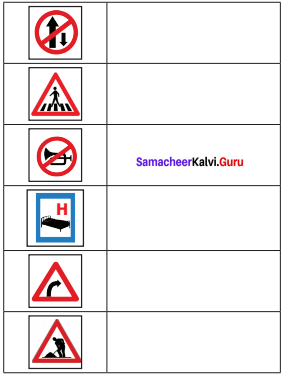
Answer:
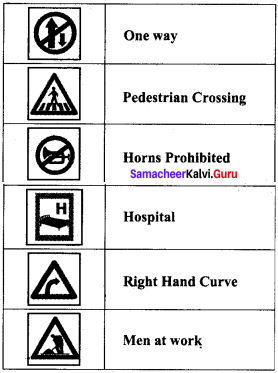
VI. Answer the following in one or two sentences
Question 1.
How do you ensure road safety?
Answer:
Road safety is primarily’ meant about to protect and provide security of all those who travel on roads.
Question 2.
Why road safety is very important to us?
Answer:
- Road accidents are undesired events that lead to injury or death.
- These deaths and injuries result in significant social and economic costs.
- The problem does not lie with roads, it is our carelessness that results in such misfortune.
Question 3.
What are the direct consequences of road accidents?
Answer:
Direct consequences of Accidents : Fatality (death), Injury, Property damage.
Question 4.
Draw traffic lights signals and indicates the meaning.
Answer:
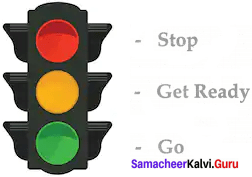
Question 5.
Write a note on Brasilia Declaration on road safety.
Answer:
Brasilia Declaration or road safety:
- Taking road safety as a serious issue, India signed Brasilia Declaration in 2015 through which the participants.
- Across the world are committed to improve road safety and ways to reduce the traffic deaths by the end of this decade.
Question 6.
What is the aim of observing Road Safety Week?
Answer:
Road Safety Week:
- Road safety week is a national event aimed at raising public awareness about traffic rules and ultimately to reduce casualties due to road accidents.
- It is also intented to reinforce road safety behaviour among road users.
Question 7.
Write any four traffic rules.
Answer:
Traffic rules in India:
- On a two – way road, the driver must drive on the left side of the road.
- It is mandatory for the driver to slow down at all inter junctions and pedestrian crossing.
- If the driver is turning left, he has to rotate the hand in the anti-clockwise direction.
- On a two – wheeler only one pillion rider is allowed.
Question 8.
How does alcohol affect driving?
Answer:
Drunken Driving:
- Consumption of alcohol reduces concentration.
- It hampers vision due to dizziness.
- And driving under the influence of alcohol causes accidents.
VII. Answer the following in detail:
Question 1.
Explain the factors contributed for road accidents.
Answer:
- Drivers – Over speeding, rash driving, violation of rules, failure, to understand signs, fatigue and consumption of alcohol.
- Pedestrian – Carelessness, illiteracy, crossing at wrong places, moving on roads and jaywalkers.
- Passengers – Projecting their body outside tie vehicle by talking to drivers, travelling on footboards, catching a running bus etc.
- Vehicles – Failure of brakes or steering, tyre burst, insufficient headlights, overloading and projecting loads.
- Road Condition – Damaged road, potholes, eroded road merging of rural road with highways, diversion and illegal speed breakers.
- Weather Conditions – Fog, snow, heavy rainfall, wind, storms and hail storms.
Question 2.
Describe the steps taken by the Government of India to prevent Road accidents.
Answer:
The Ministry of Road Transport and Highways has taken a number of steps to prevent road accidents and road accident fatalities. These include:
1. A multi – pronged strategy:
A multi – pronged strategy has been adopted based on four Es – Engineering, Enforcement, Education and Emergency care for ensuring road safety.
2. Improving Vehicular Safety Standards:
Trucks are prohibited from carrying pr&truding rods. Anti – locking Brake System (ABS) has been made mandatory on heavy vehicles. Induction of ABS/CBS for two wheelers are made mandatory.
3. Pilot Projects for Cashless Treatment of Road Accident Victims:
This project has already done in the stretch of NH 8 and NH 33. Now it is proposed to implement this scheme along the Golden Quadrilateral, North South and East West Corridors.
4. Quick response ambulances:
Quick response ambulances are parked in every 50. kms on the National Highways by the National Highway Authority of India (NHAI). A 24 x 7 call centre to receive calls for ambulances has been created and training has been given for providing first aid to road safety volunteers.
5. Speed Governors:
This device has a series, of sensors that can detect how fast a vehicle is going and if this crosses the limit set by it, it restricts the flow of air and fuel to the engine. This automatically slows down and stops the vehicle from crossing the pre – determined speed.
6. Variable Message Signs:
These are LED boards which can display important information that needs to be communicated to commuters. These can be used to update road users the traffic conditions in case of major breakdowns, congestion and so on.
Question 3.
What are the preventive measures of road accidents?
Safety Measures:
1. Always keep to the left-While driving, keep to the left and allow vehicles to pass from the opposite direction.
2. Use helmets – Make it a habit of strapping the helmet before mounting the bikes.
3. Never exceed the speed limit – The speed limit is related to the traffic condition of the area. So maintain speed limit.
4. Maintain the right distance – Collisions occur because we do not maintain adequate distance from the vehicle in the front. So maintain a safe distance from the bigger vehicles.
5. Park the vehicles only along the designated parking bays / zones not on the sides of the high ways.
6. Follow the road signs – Road signs are mostly pictorial so it is not hard to comperhend.
7. Some other safety tips are – Never ever drive when drunk, never use cell phone while driving, avoid listening to too loud music, check your mirrors before changing lanes.
8. Never cross on red and yellow light. Take a sidewalk and avoid walking on the roads.
VIII.HOTs
Question 1.
What is the requirement for a two wheeler rider during night?
Answer:
Few tips for Riding (Motor cycle) two wheeler during night:
- Upgrade your bike’s lightings.
- Increase your visibility to others on the road.
- Be ensured that your vision is clear.
- Use the lights of other vehicles equally.
- Ride slowly.
- Keep control your speed.
- Take adequate rest.
- Proper planning.
Question 2.
Tabulate tips for avoiding driver fatigue.
Answer:
Some of the tips are as follows:
- Prevent driver Fatigue – Plan to get a sufficient amount of sleep before driving.
- Driving – Shoot for at least 6 hours, but 8 hours is recommended.
- Avoid – Avoid consuming any alcohol when you will driving late night.
IX Project and Activity
Question 1.
Tabulate a few basic road safety rules for children.
Answer:
- Know your signals
- Stop, look and cross
- Pay attention – Listen
- Don’t Run on Roads
- Always use sidewalks
- Cross roads and Pedestrian crossing
- Never cross road at bends
- Staying safe on a bicycle
Question 2.
Demonstrate road safety techniques.
Answer:
Defensive Driving Behaviour:
- Drive defensively
- Avoid all distractions – keep both eyes on the road and hands on the steering wheel.
- Be visible – drive with your lights on.
- Headlights should be dipped well before an approaching vehicle is within range of the main beam.
- Stay within the speed limit at all times.
Question 3.
Prepare Road Safety Awareness pocket guide and calculate in school.
Answer:
Activity to be done by the students.
Samacheer Kalvi 8th Social Science Civics Road Safety Rules and Regulations Additional Questions
I. Choose the correct answer:
Question 1.
The Ministry of Road Transport and Highways has taken a number of steps to prevent …………..
(a) Road Safety
(b) Road Accident
(c) Improper Lights
(d) None of these
Answer:
(b) Road Accident
Question 2.
At a green light
(a) You can keep going if the path looks clear
(b) You must stop and wait for it turn green
(c) Quickly you can reply your friends text message
(d) You can attend call immediately
Answer:
(a) You can keep going if the path looks clear
Question 3.
………….. can cross the road only at Zebra crossing.
(a) Animals
(b) Birds
(c) Pedestrians
(d) All of these
Answer:
(c) Pedestrians
Question 4.
………….. week is celebrated in the month of January every year.
(a) Road safety
(b) Railway safety
(c) Air safety
(d) Water safety
Answer:
(a) Road safety
Question 5.
Road safety is ………….. meant about the protection and security of all road users.
(a) Primary
(b) Secondary
(c) Tertiary
(d) All of these.
Answer:
(a) Primary
Question 6.
The rule of the road regulation was brought into effect from 1st July …………..
(a) 1999
(b) 1989
(c) 1979
(d) 1990
Answer:
(b) 1989
Question 7.
………….. program was launched in 2016.
(a) Mandatory Signs
(b) Setu bharatam
(c) Agricultural
(d) Safety rules
Answer:
(b) Setu bharatam
Question 8.
Example for weather condition.
(a) Fog
(b) Snow
(c) Heavy Rainfall
(d) All of these
Answer:
(d) All of these
Question 9.
The main motive behind ………….. is saving time.
(a) Red Light Jumping
(b) Drunken driving
(c) Over Speeding
(d) None of these
Answer:
(a) Red Light Jumping
Question 10.
Never cross on ………….. and ………….. light
(a) Green and Red
(b) Red and Yellow
(c) Yellow and Green
(d) Yellow and Red
Answer:
(b) Red and Yellow
Question 11.
Call ………….. for help and for traffic accidents.
(a) 102 and 108
(b) 108 and 105
(c) 108 and 103
(d) 106 and 105
Answer:
(c) 108 and 1031
Question 12.
………….. lines are used on dangerous roads.
(a) Solid White Line
(b) Broken White Line
(c) Stop Line
(d) Double Solid Yellow Line
Answer:
(d) Double Solid Yellow Linel
Question 13.
Avoid listening to too ………….. music.
(a) low
(b) loud
(c) soft
(d) melody
Answer:
(b) loudi
Question 14.
The Motor Vehicle Act was passed on ………….. Parliament.
(a) 1980
(b) 1990
(c) 1988
(d) 1992
Answer:
(c) 1988
Question 15.
On a two-way road, the driver must drive on the ………….. side of the road.
(a) left
(b) right
(c) centre
(d) both left and right
Answer:
(a) left
Question 16.
Flashing Red Signal means to come to complete …………..
(a) Go
(b) Stop
(c) Both ‘a’ and ‘b’
(d) Slow
Answer:
(b) Stop
Question 17.
………….. are prohibited from carrying protruding roads.
(a) Buses
(b) Cars
(c) Trucks
(d) Vans
Answer:
(c) Trucks
Question 18.
There are three type of ……………
(a) Traffic signs
(b) Road Safety
(c) Road Safety Act
(d) All the above
Answer:
(a) Traffic Signs
Question 19.
Expand NSC
(a) National Safety Council
(b) National Sample Commission
(c) National Safety Commission
(d) National Sample Commission
Answer:
(b) National Safety Council
Question 20.
India Signed Brasilia Declaration in …………..
(a) 2014
(b) 2013
(c) 2015
(d) 2016
Answer:
(c) 2015
II. Fill in the blanks
- ………….. Signs warns the user regarding road situation a head.
- Yellow number plate is for ………….. vehicle.
- Setu Bharatam program was launched in …………..
- 304 A is the Indian ………….. code.
- it refers to

- it refers to
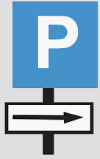
- The Motor Vehicle Act was passed on ……………
- Single Solid Yellow Lines used in areas where variability is ……………
- Use of …………… in four wheelers.
- Use of …………… in two wheelers.
- …………… is done to detect consumption of alcohol.
- …………… is given to a vehicle that is used by foreign ambassadors.
- White Number Plate is used in cars by ……………
- Setu Bharatam aims to make all National Highways free of railway level crossing by ……………
- Expand – AHO ……………
- Brasilia Declaration on Road Safety is the Second level High level conference on road safety co-sponsored by the ……………
- …………… are undesired events.
- On …………… the driver should allow the overtaking vehicle through the right.
- …………… Signal indicates you may go if the way is clear.
- …………… Signal indicates to stop behind the stop line.
Answer:
- Cautionary
- Commercial
- 2016
- Penal
- Right Hand Curve
- Park this side
- 1988
- low
- seat belt
- helmet
- Random breath test
- Blue number plate
- Common Citizen
- 2019
- Automatic Headlight On
- WHO
- Accidents
- one way road
- Green
- Red
III. Match the following

Answer:
- c
- d
- e
- b
- a

Answer:
- a
- d
- e
- c
- b
IV. State True or False
- Road accidents are undesired events that leads to make as happy.
- Consumption of alcohol increases concentration.
- The main motive behind red light jumping is saving time.
- Call 103 for traffic accident.
- Call 108 for fire accident.
- Anti – locking Brake System (ABS) has been made mandatory on heavy vehicles.
- Cross only at Zebra crossing.
- The rule of the road regulation was brought into effect from 1st July 1999.
- Green Signal indicates you may go if the way is clear.
- The speed limit is related to the traffic condition of the area and maintain speed limit.
- Cautionary signs are generally, in square shape.
- Flashing Yellow Signal indicates a slow down and proceed with caution.
- Informatory Signs not gives information regarding directions and destination etc.
Answer:
- False
- False
- True
- True
- False
- True
- True
- False
- True
- True
- False
- True
- False
V. Consider the following statements and Tick (✓) the appropriate answer
Question 1.
Which of the following statements is / are correct:
(i) Road safety is primarily meant about the protection and security of all road users.
(ii) We should not follow the road safety rules and signs.
(iii) We must use seat belt for four wheeler.
(iv) We shouldn’t use helmet for motor cycle / two wheeler
(a) (i), (ii), (iii) & (iv) are Correct
(b) (i) & (iii) are Correct
(c) (ii) and (iv) are Correct
(d) (i), (ii) and (iv) are Correct
Answer:
(b) (i) and (iii) are Correct
Question 2.
Assertion (a) : Consumption of Alcohol reduces concentration.
Reason (R) : Drunken Driving hampers vision due to dizziness.
(a) A and R are correct and R is the correct explanation of A
(b) A and R are true but R is not the correct explanation of A
(c) A is true but R is false
(d) A is false but R is true
Answer:
(a) A and R are correct and R is the correct explanation of A
Question 3.
Which of the following is correctly matched?
(a) Over speeding – Good for driving
(b) Single Solid Yellow Lines – It is used where visibility is low
(c) 108 – Call for traffic accident
(d) Accident take place – Only night time
Answer:
(b) Single Solid Yellow Lines – It is used where visibility is Sow
Question 4.
Which of the following is not correctly matched?
(a) Solid White Line – Seen on areas of strategic importance
(b) Cars – Seat belt
(c) Traffic signs – Cautionary signs
(d) Red Number Plate – Commercial Vehicle
Answer:
(d) Red Number Plate – Commercial Vehicle
Question 5.
The following signs represent:
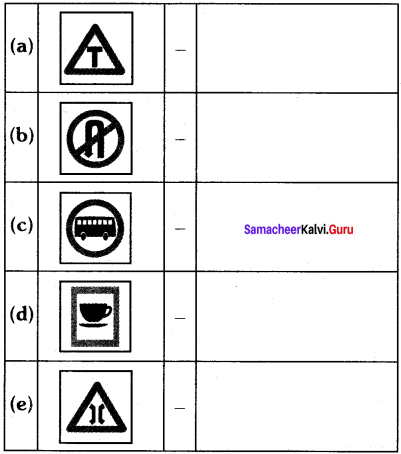
Answer:
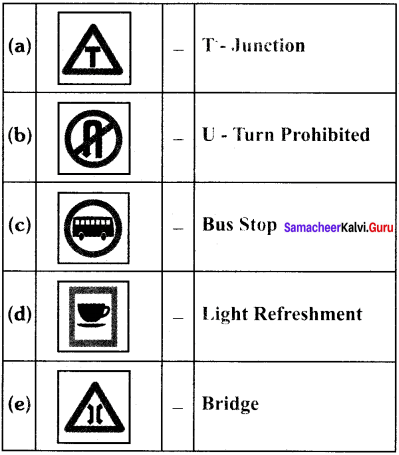
VI. Answer in one or two sentences:
Question 1.
Write a short note on Decade of Action for Road Safety 2011 – 2020.
Answer:
- Decade of Action for Road Safety 2011 – 2020, officially proclaimed by the UN General Assembly.
- The decade seeks to save millions of lines by improving the safety of roads and vehicles, enhancing the behavior of road users.
Question 2.
What are the three types of traffic signs?
Answer:
- Mandatory Signs
- Cautionary Signs
- Informatory Signs
Question 3.
Write a short note on steady Green Arrow Signal.
Answer:
- Green Arrow signal may be provided in addition to the full green signal.
- This indicates to proceed with caution in the direction the arrowing points.
Question 4.
List out the Universal Colour Code.
Answer:
- Red
- Yellow
- Green
- Steady Green Arrow Signal
- Flashing Red Signal
- Flashing Yellow Signal
Question 5.
What do you mean by Mandatory signs?
Answer:
- Mandatory sign give order and need to be followed strictly.
- They are generally circular in shape.
Question 6.
What are Informatory signs?
Answer:
- Informatory sign give information regarding directions, destinations etc.
- They are generally rectangular in shape.
Question 7.
Draw the three types of Traffic Signs.
Answer:
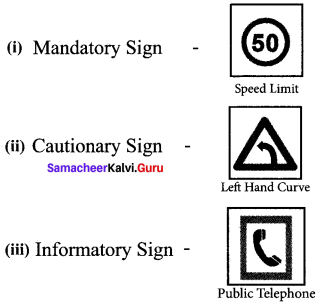
VII. Answer the following in detail:
Question 1.
Describe briefly explain in traffic signals.
Answer:
Traffic lights is a signalling device that is positioned at a road intersection, pedestrian crossing to indicate when it is safe to drive, ride or walk using a universal colour code.
1. Red – This signal indicates to stop behind the stop line.
2. Amber (Yellow) – This signal indicates stop. Do not pass through or start until green shows. If, by mistake, you are caught in yellow signal in the middle of a large road crossing, continue with care and do not accelerate in panic.
3. Green – This signal indicates you may go if the way is clear.
4. Steady Green Arrow Signal – This signal may be provided in addition to the full green signal. This indicates to proceed with caution in the direction the arrow points.
5. Flashing Red Signal – It means to come to complete stop. Proceed only when the way is clear.
6. Flashing Yellow Signal – It indicates to slow down and proceed with caution.
Question 2.
What are Traffic Signs? Explain the different types of traffic signs.
Answer:
Traffic Signs:
- Traffic signs are there to regulate Traffic warn about hazards and to guide the road users.
- Understanding traffic signs is essential.
- We should have a proper knowledge of traffic signs.
There are three types of traffic signs. They are:
1. Mandatory Signs:
- It give order and need to be followed strictly.
- They are generally in circular shape.
2. Cautionary Signs:
- Warns the user regarding road situation ahead.
- They are generally in triangular shape.
3. Informatory Signs:
- It gives information regarding directions, destinations, etc.
- They are generally in rectangular shape.